 |
 |
 |
A Nintendo community
by the fans!
|
 |
 |
∧ |
Forum main |
|
 |
Top Ten 3DS Virtual Console Wishlist Part 4: Turbografx 16 (TurboExpress) [top ten]
|
|
|
 |
 |
|
 |
04/13/11, 07:15 Edited: 08/30/11, 07:13
|
|
|
|
|
 |
 |
 |
|
 |
 |
|
 |
 |
|
 |
 |
 |
 |
 |
Release Date: 1989 Developer: Namco Publisher: Namco Splatterhouse is the first game in a series of beat ‘em ups that started its life in the arcades. Unlike other beat ‘em ups of its era, like Double Dragon, the main character, Rick, can only move from left to right, as opposed to the eight directions that the Lee brothers can move in. The story revolves around a young parapsychology student, the aforementioned Rick, who, along with his girlfriend Jennifer, goes to the house of the mysterious Dr. West in order to explore the haunted mansion known as Splatterhouse. The place earned its name because Dr. West, allegedly created hideous creatures inside. Of course, this was just a rumor, because no one who had gone to investigate had ever come back alive. As they went inside the mansion, they were attacked in the dark by unseen forces. Jennifer was kidnapped while Rick was left to die in a pool of his own blood. He awoke hours later with a mask attached to his face. He recognized this “Terror Mask” from Dr. West’s writings and he knew that he needed its ancient spiritual powers to get Jennifer back. I’ve been a fan of the Splatterhouse series since I played the third one on the Sega Genesis. It was such a different game, Double Dragon mixed with an 80’s horror movie. Afterwards, I sought out the first two and, while not as good as the third one, they still had that great horror atmosphere that made it different from other games of its time. Trivia: Due to its violent nature as well as some questionable enemies, the TurboGrafx16 port of Splatterhouse had a humorous "parental advisory warning" of sorts printed on the front of the box. This warning read as follows: "The horrifying theme of this game may be inappropriate for young children... and cowards." The first and most noticable difference is that Rick is wearing a red mask in the Turbografx version. In the arcade (and PC Engine) game, the mask is white and resembles a goalie's mask. This one is solid red, with black eyeholes and two curving horizontal black stripes. Rick wears what resembles a white variation of this mask in the Mega Drive version of Splatterhouse 2. Graphically, the arcade game had a lot more detail and animation. The backgrounds and foregrounds were a lot more detailed in the arcade game - understandably, as the Turbo couldn't quite match the graphic abilities of Namco's arcade hardware. A lot of the creatures had several frames of animation removed from the Turbo game. The gore was toned down quite a bit in the Turbo game as well. The sound effects were also toned down. Of course, one of the biggest changes to the Turbo game was the removal of the level four boss from the arcade, the floating upside-down cross. It's been replaced with a floating blue monster head called "Evil Sleep", and the heads that it creates are called "The Nightmares". While the stage 4 boss (called "Evil Cross" in the PC Engine manual) is censored in the Turbo version, the original Japanese PC Engine version leaves it intact. 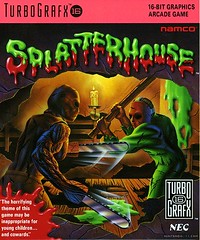 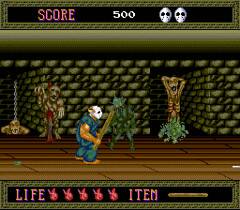
|
|
 |
 |
 |
 |
|
|
 |
 |
 |
|
 |
 |
|
 |
 |
 |
 |
 |
Release Date: 1991 Developer: Seibo Kaihatsu, Inc. Publisher: NEC Raiden is a Turbografx 16 port of the vertical scrolling shoot ‘em up from the arcades. In it, you play the nameless pilot of the Raiden Supersonic Attack Fighter, a backwards engineered aircraft based on the ships from an invasion force that is attacking Earth in the year 2099. Just like any shooter from the last few decades, it’s one ship against an entire army of aliens. You have a couple of weapons at your disposal, the vulcan which can be leveled up to 8 levels, the Laser which fires forward concentrating shots, the homing and nuclear missile sub-weapons which can be leveled to level 4, and bombs which clear out all bullets onscreen and damage enemy aircrafts. I have never played this game, but I know that it is held in high regard. As a fan of old-school shooters, I cannot wait to play this game on the 3DS VC. Trivia: Ports to both Atari Falcon and Amiga were well underway, undertaken by Imagitec Design, but both were eventually scrapped. Unfinished versions have been circulating on the net and pirate BBSes for some time. Unlike most Raiden versions, these computer ports featured a "marquee" covering much of the screen, a move which had been out of fashion since the eighties, when it was often used to cover up the bad scrolling hardware of older computers. The game system in Raiden has often been compared to Toaplan's vertical shooters, and indeed Seibu Kaihatsu used Twin Cobra for research during the development of Raiden. The title in Japanese translates to "Thunder and Lightning". Rai means thunder, and den means lightning. 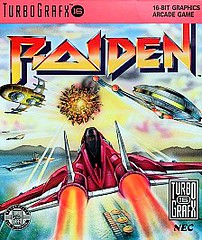 
|
|
 |
 |
 |
 |
|
|
 |
 |
 |
|
 |
 |
|
 |
 |
 |
 |
 |
Release Date: 1990 Developer: Alpha System Publisher: NEC Fighting Street is a port of none other than the original Street Fighter Arcade game. There are only two playable characters, Ryu (Player 1) and Ken (Player 2). The player fights in a tournament against computer controlled characters in one-on-one fights. The player must win two rounds in order to advance in the tournament ladder. Since the Turbografx 16 pad only had two buttons, the strength of a punch or a kick was determined by the length of time the button was held down. Besides normal attacks, the player could also use three special attacks: White Fire (Hadouken), Hurricane Kick, and Dragon Punch (Shoryuken). This game also introduced the bonus rounds that have been a staple of the Street Fighter series, which consisted of table and brick breaking games. I’ve been a fan of the Street Fighter series since this game. I remember going to Pizza Hut and sneaking off to play a few rounds before the food came. I was never very good at this game, but to be fair, who is? The controls weren’t all that great and the game relied more on the power of the special moves to win. However, it was great for its time and I would love to have it in my portable collection. Trivia: Characters who appeared in subsequent Street Fighter games include: Ryu, Ken, Gen, Birdie, Eagle, Adon, and Sagat. Street Fighter was directed by Takashi Nishiyama (who is credited as "Piston Takashi" in the game) and planned by Hiroshi Matsumoto (credited as "Finish Hiroshi"), who both previously worked on the overhead beat 'em up Avengers. The two men would leave Capcom after the production of the game and were employed by SNK, developing most of their fighting games. The Turbografx 16 version features an arranged soundtrack. Graffiti on the Lockheads pub wall in the Birdie Stage bears the name and likeness of Bill Cravens, who was the Capcom USA VP of Sales & Marketing. Sagat is the final boss of this game. At the end of Street Fighter, only one fighter managed to reach Sagat: a young martial artist named Ryu. Initially, Sagat was able to pin Ryu, and was sure that he was the winner of the match, even going to help Ryu up. However, Ryu became desperate to win the fight and was consumed by the Satsui no Hadou and his "Evil Ryu" side and executed the Metsu Shoryuken, grievously wounding Sagat and leaving a massive scar across his chest. Because of this event, Sagat has sworn revenge on Ryu. Evil Ryu is a playable character in several Street Fighter games, including the upcoming Street Fighter IV Arcade Edition game.  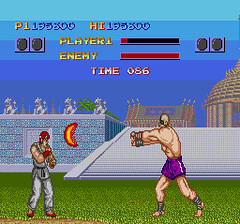
|
|
 |
 |
 |
 |
|
|
 |
 |
 |
|
 |
 |
|
 |
 |
 |
 |
 |
Release Date: 1989 Developer: Irem Publisher: NEC R-Type is a port of the side-scroller shoot ‘em up of the same name. In it, an unnamed pilot (again) from the 22nd century takes control of a lone ship (again), the R-9A Arrowhead in order to singlehandedly free humanity from an invading alien force (again). Originality issues aside, R-Type was an amazing game. It featured excellend graphics and music and unique gameplay. The scrolling of the screen was slower than other shoot ‘em ups and you powered up by using equipping armaments that you get from destroying POW Armors. The enemies designs were also fantastic as they employed cybernetic organisms such as the one pictured below. My first foray into the R-Type series was with Super R-Type for the SNES. I loved that game to death and I became a fan of the franchise ever since. Even though, R-Type for the Turbografx is not as great a game as Super R-Type, I think it deserves a place in the 3DS Virtual Console because it marked the beginning of such a remarkable franchise which, unfortunately, has not been as prevalent during the last few years. It also features a lot of elements, such as the armaments and huge enemies that would become a staple of the franchise. Trivia: The series received it's name from the titular R-Series ships; in this case, the R-9A Arrowhead. The "R-Type" refers to the Round-Canopy, a trait held by nearly every R-craft ever built. The origins of the Bydo Empire were not fully known when the game released, but they have evolved into a complex example of retrocausality: where humankind disposed of an experimental weapon into an alternate dimension and that weapon frees itself into mankind's own past. From Irem's official R-Type webpage: The Bydo were created by mankind in the 26th century to be used as weapons of ecological destruction against our enemies within the galaxy. Unlike conventional weapons of defense, the Bydo were conceived as limited range weapons with the purpose of destroying every ecological form in their path. The Bydo were placed inside a container almost as large as the moon where they consumed everything and continued to evolve. A combination of physics, genetic engineering, and black magic resulted in man-made creatures of evil. Mankind intended to send the Bydo through a wormhole to the enemy solar system to annihilate their planet. Everything appeared to be going as planned. However, there was a slight error and the Bydo became active in our own solar system. For 150 hours they raged until they were carried away to another dimension by a special weapon. It appeared that mankind in the 26th century was safe. However, the Bydo were still alive and continued to evolve in another dimension. After wandering for what seemed like an eternity, they reappeared in the 22nd century to demonstrate their power against Earth.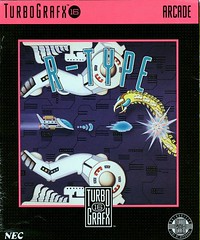 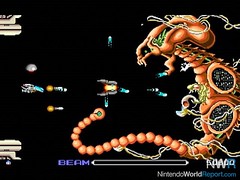
|
|
 |
 |
 |
 |
|
|
 |
 |
 |
|
 |
 |
|
 |
 |
|
 |
 |
 |
 |
 |
Release Date: December 12, 1992 Developer: Red Company Publisher: Hudson Soft Air Zonk is a sidescrolling shoot ‘em up, in which you play a cyborg called Zonk. It is different from other shoot ‘em ups in that you control a humanoid character instead of a ship, and you have a large number of powerups and companion characters at your disposal. These companions help the main character by attacking enemies and by granting Air Zonk special attacks and, occasionally, temporary invulnerability. I’ve always wanted to play the Zonk Series of games because they are considered to be some of the best games on the system. I’m pretty sure that we will see them on the 3DS sooner than later. I am most interested to play Air Zonk, rather than its sequel Super Air Zonk: Rockabilly Paradise, because it is considered to be the best of the two. Trivia: The protagonist in this game, Zonk, is a cyborg version of Bonk--the mascot for NEC Corporation's TurboGrafx 16 video game console. When TTi released the DUO console (successor to TurboGrafx-16), Zonk was adopted as the official mascot. Zonk adorned nearly all of TTi's promotional material, and was even featured on the package art for the TurboDuo console. Before the game's release in the United States, TTi held a contest to name the character. Zonk's temporary name had been "Bonkinator" [2], but by the August/September, 1992 issue of TurboPlay Magazine[3], the name "Air Zonk" had been chosen. . The developers of this game, Red, were also the force behind the critically acclaimed Gate of Thunder series. The game can be considered as being part of the Bonk series of games, as it features the same antagonist, King Drool, and many of the same enemies and artistic styles.  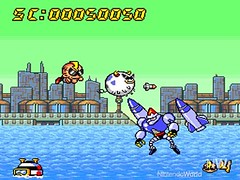
|
|
 |
 |
 |
 |
|
|
 |
 |
 |
|
 |
 |
|
 |
 |
|
 |
 |
 |
 |
 |
Release Date: 1990 Developer: Red Company; Atlus Publisher: NEC In the Bonk games, you play as Bonk (of course) a caveman who attacks enemies using his huge head. Bonk became NECs mascot until Air Zonk came around. Bonk used his head to attack enemies and his teeth to climb up walls, and he was also able to float down to the ground by spinning in the air. In the first game, Bonk must fight prehistoric baddies in order to rescue Princess Za (a dinosaur) from the evil King Drool. In the second game, Bonk’s Revenge, Bonk is on a quest to recover half of the moon which was stolen from King Drool. In the third game, Bonk 3: Bonk’s Big Adventure, Bonk is on a quest to rid the world of King Drool once and for all. This game introduced new gameplay mechanics such as cooperative multiplayer. Bonk was the first Turbografx 16 game that I ever played. A neighbor of mine had it and I would always go to his house to play it. I loved the character and the gameplay which was unique in that era. Unfortunately, I moved away and have not met anyone else with a T-16 console since. I know I can buy it on the Wii Virtual Console but this franchise just seems like a better fit for a portable. Of all the Bonk games, the one I’m most interested in is the first one, the one I fell in love with all those years ago. Trivia: Bonk appeared in the Sega Saturn game "Saturn Bomberman" as a playable character in multiplayer mode. This was hi only appearance ever on a SEGA console. In the original game, the second power-up stage turns Bonk into a caveman, but in the Japanese versions of the second and third games, he becomes a cavewoman. The caveman transformation was re-used for the western entries in the series, as the gender transformation may have been considered inappropriate for the target demographic outside Japan. In the Japanese version of the second game, the ending sequence opens with karaoke-style theme song subtitles. This song was completely absent from foreign releases. Also, the drawing of Bonk during the credits is completely different between both versions.  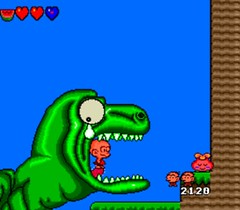
|
|
 |
 |
 |
 |
|
|
 |
 |
 |
|
 |
 |
|
 |
 |
 |
 |
 |
Release Date: 1991 Developer: Hudson Soft Publisher: Turbo Technologies, Inc. I’ve said it before and I’ll say it again. Every console should have a Bomberman game. The Turbografx 16 had 3. These were Bomberman, Bomberman ’93, and Bomberman ’94 (Japan only). In the first game, the White Bomberman must save the daughter of his inventor from the Black Bomberman. In ’93, the White Bomberman must restore his city’s electricity which was taken away by the Black Bomberman. In ’94, which was only released in the west for Sega Consoles, Bomberman must restore Bomber Planet, which was split into five pieces by the evil Bagular. All Bomberman games have similar gameplay. You play as Bomberman and you must pass each stage by defeating all other enemies in the area and finding the hidden exit. The best part about each Bomberman game is the multiplayer. If Nintendo can somehow make the multiplayer work by using the 3DS wireless functions, these games will be must owns. I am most interested in Bomberman ’94 because it has all the elements from previous games plus the new kangaroo creatures, Roois. Trivia: Bomberman is a remake of the first game in the series. Bomberman was released in Europe on Commodore Amiga, Atari ST, and MS-DOS, under the name "Dyna Blaster." Despite the Mega Drive being the more powerful console, the porting of Bomberman '94 to the Mega Drive actually has inferior graphics to the original version, and can only support 4 players in multiplayer instead of 5 as in the PC Engine version. There are also some changes in the soundtrack. Bomberman ’94 introduced Female Bomberman and Bomberman Max.  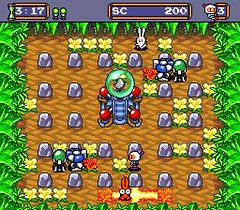
|
|
 |
 |
 |
 |
|
|
 |
 |
 |
|
 |
 |
|
 |
 |
 |
 |
Castlevania: Rondo of Blood |
 |
Release Date: October 29, 1993 Developer: Konami Publisher: Konami Known in Japan as Akumajō Dracula X: Chi no Rondo, Castlevania: Rondo of Blood was the only Castlevania game released for the PC Engine. It features 2D platforming gameplay like the old school Castlevanias, but with a twist. This game had multiple paths throughout most stages which, if you found them, gave you access to alternate stages with different environments and bosses. The game also featured multiple endings for the first time in the series, something that would become a staple of the franchise. Though the game featured traditional weapons such as the Vampire Killer and subweapons, it introduced the Item Crash ability which allowed the player to use a set amount of hearts in order to use the hidden abilities of the subweapons, not unlike using super attacks in a fighting game. The game revolves around Richter Belmont’s quest to rescue his love Annette from the clutches of Shaft (no, not that Shaft), Dracula’s High Priest. In order to get the best ending, you also have to rescue Annette and three other girls, including Maira Reinhart, who becomes a playable character with her own unique moveset, powerups, and Item Crashes. The game also featured CD based music and Full Motion Video cutscenes for the first time in the series. The music was excellent, unfortunately the cutscenes were not. The animation was stiff and the designs were bad, though not as bad as the CDI Zelda games. Even so, they did not detract from the enjoyment of the game at all. They just moved the story along in a cheesy way. Castlevania is one of my all-time favorite series and Castlevania: Rondo of Blood is one of the best games in the franchise. It is already available in the Wii Virtual Console, so I believe that it has a very good chance of making it to the 3DS Virtual Console. Trivia: The "X" in the Japanese title refers the Roman digital "X" (10) because the game is the tenth game in the Castlevania series. This was the first Castlevania title to feature a complete "anime" style in its design. While this style had existed and influenced the series prior to Dracula X, it is more prominent here than ever before. This is the first game in the series to feature voice actors and recorded dialogue. A number of enemies, such as the spearmen and skeleton apes are introduced for the first time, and many of the sprite designs for this game were very influential in further 2D Castlevania design, particularly in Castlevania: Symphony of the Night. Rondo means "circle", thus it is sometimes known as "Circle of Blood." All the bosses Shaft resurrects are original bosses from "Castlevania." The soundtrack for the game was released in a two disc set (the second disk containing the soundtrack to Castlevania: Bloodlines) in 1994 and has since been taken out of production, making it just as hard to find as the game is. The game is highly sought after by many fans, but due to the lack of a North American release, copies are rare. The game often sells for well over $100 on ebay. It has been upgraded to a 2.5D game in Castlevania: Dracula X Chronicles on the PSP, which also contains the original version as well as its sequel, Symphony of the Night. A direct port of the original version can also be found on the Wii's virtual console and is considered an import title outside Japan. While there is no translation made outside of Japan, the English VC version is still altered in that it contains the PSP intro audio and the censored version of the werewolf. There is also a Castlevania game that's considered to be a semi-remake/semi-sequel of sorts to Rondo of Blood called Castlevania: Dracula X (Akumajō Dracula XX in Japan) which was released for the Super Nintendo two years later, but it wasn't well received by the fans and critics who noticed substantial and negative differences from the original title. As a result, the PC Engine Super CD version is considered one of the hallmarks of the Castlevania series. While you can save Annette's little sister, Maria, on Stage 4, she is not a playable character as she was in the original Rondo of Blood game for the PC-Engine. Also worth noting is the fact that both Tera and Iris are completely absent from this version, as well as the dark priest Shaft.  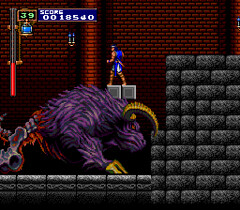
|
|
 |
 |
 |
 |
|
|
 |
 |
 |
|
 |
 |
|
 |
04/13/11, 07:15 Edited: 08/30/11, 07:13 |
|
|
|
|
 |
 |
 |
|
 |
 |
|
 |
|
|
 |
 |
|
 |
 |
|
|
|
|
|
|
|
|
|
|
|
 |
 |
 |
 |
Another great list from sirmastersephiroth, the opening of the 3DS store can't come soon enough!  OK, so I had not even realized before that TurboExpress was basically a handheld that played TurboGrafx-16 games. I'm slow. I'm not that familiar with the TG16 library aside from what's been available on the Wii Virtual Console. There sure were a bunch of SHMUPs though. The Bonk games are fun, I played 1 and 2 for the first time on Wii VC. I have been meaning to get Rondo of Blood and Gate of Thunder for Wii VC as well, but with my current backlog, I may end up getting them on 3DS instead! I remember there was a WiiWare update to Star Soldier but I heard it wasn't that great. @anon_mastermind I've heard very good things about Devil's Crush. The original Alien Crush is currently on my Wii VC wishlist. |
 |
 |
 |
 |
|
|
|
|
|
|
|
|
 |
 |
 |
∧ |
Forum main |
|
|




